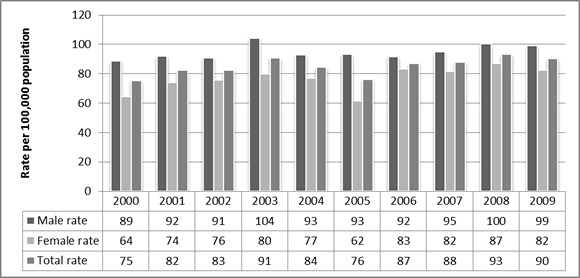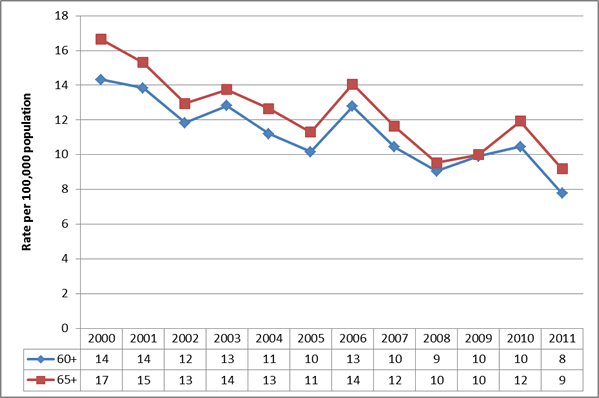Indicator 26: Mortality rates
| Indicator is fully reported? | The indicator is partially reported for deaths from all external causes and poisoning, accidental falls, drowning, motor vehicle accidents, and suicide. Partial data might be reported when the numbers of deaths from specific causes are too small to produce meaningful mortality rates. |
| Type of indicator |  Outcome indicator Outcome indicator |
| Other relevant indicators | NA |
| Our findings |
How deaths are categorised The causes of death can be organised into three groups. Deaths can be from:
Some deaths from external causes can be prevented by universal or targeted interventions that governments can introduce. Good-quality data is needed to help set priorities for public spending to reduce deaths from external causes, or to decide whether resources would be better used to decrease deaths from communicable or non-communicable diseases. Data is also needed to know whether the interventions are effective. The types of deaths discussed here The category of external causes and poisoning includes deaths from events such as falls, motor vehicle crashes, suicide, and drowning. We show mortality rates for all of these, except drowning, in Figure 1. (The number of deaths by drowning is small.) The data shows that the mortality rate from external causes and poisoning per 100,000 population for people aged 60+ increased since 2000. |
| How entities use the data |
Accidental falls There has been a national focus on reducing the incidence and impact of falls since 2001.[2] The Accident Compensation Corporation (ACC) is the lead government agency for the national falls prevention strategy.[3] The strategy aims to reduce the incidence and severity of injury from falls. It guides the activities of Government, health agencies, service providers, non-government, and community organisations to provide services in a co-ordinated and collaborative way. The implementation plan for the strategy expired in 2010. ACC told us (on 30 January 2013) that it was updating the implementation plan and expected to finalise it in mid-2013. Health Quality and Safety Commission New Zealand is the lead agency for establishing a programme to reduce the harm from falls in health-care settings. Data published in a series of reports of serious and sentinel events occurring within the health sector have identified harm from falls as a major cause of injury to patients in hospital.[4], [5] Action will be taken at the individual, system, and population levels.[6] At the individual level, the focus will be on preventing falls and reducing the harm from falls for Maori/Pacifica people aged 55+ and non-Maori/Pacifica people aged 75+:
Motor vehicle crashes Older road users are more physically vulnerable to injury and the number of deaths and serious injuries are expected to increase as the population ages. This is one reason the National Road Safety Committee, which is responsible for implementing Safer Journeys 2010-2020, identifies the road safety of older people as a continuing and emerging focus.[9] The aim is to decrease the mortality rate for people aged 65+ from 15 per 100,000 population to 11 per 100,000 population by 2020. Indications are that this might be achieved before then (see Figure 4). Deaths from suicide The Ministry of Health is lead agency for the New Zealand Suicide Prevention Strategy 2006-2016. The strategy noted that, although suicide rates in the elderly had been declining over time, they remained relatively high and (until recently) the risk was often overlooked in that population.[10] Since 2006, some initiatives have been broadly based and include older people.[11] |
| Entity responsible for this indicator | ACC is the lead agency for the national falls prevention strategy. The Health Quality and Safety Commission is the lead agency for reducing harm from falls in health care settings. The Ministry of Health is responsible for the New Zealand Mortality Collection. The Ministry of Transport is the lead agency for road safety. Statistics New Zealand publishes the serious injury outcome indicators. |
Figure 1:
Summary of mortality rates from external causes
| Mortality rate per 100,000 population for people aged 60+ | ||||
| 2000 | 2009 | 2010 | 2011 | |
| All external causes and poisoning (see Figure 2 for more detail) | 75 | 90 | - | - |
| Accidental falls (see Figure 3 for more detail) | 37 | 53 | - | - |
| Motor vehicle crashes (see Figure 4 for more detail) | 14 | 10 | 10 | 8 |
| Suicide (age 65+) |
About 10[12] |
- |
9.7[13] |
- |
Note: The mortality rates for falls, motor vehicle crashes, and suicides does not total the figures given for all external causes and poisoning. This is because the datasets are different and data for death from other external causes, such as drowning, are not provided.
Figure 2:
Death rates from external causes of injury and poisoning for people aged 60+ by year of registration
From 2000 to 2009, the total death rate increased by 15 and was higher for men than for women.

Source: Ministry of Health, 2013.
Figure 3:
Death rates from accidental falls for people aged 60+ by year of registration
From 2000 to 2009, the total death rate increased by 16 and was usually higher for women than men.

Source: Ministry of Health, 2013.
Figure 4:
Death rates from motor vehicle crashes for people aged 60+

Source: Ministry of Transport, 2013.
[1] The Global Burden of Disease Study 2010 includes maternal, neonatal, and nutritional causes of death in the communicable diseases category. More information about the study and the country profile for New Zealand (published in 2013) is available at www.healthmetricsandevaluation.org/gbd/publications/policy-report/global-burden-disease-generating-evidence-guiding-policy and www.healthmetricsandevaluation.org/gbd/country-profiles.
[2] Ministry of Health (2001), New Zealand Health Strategy, page 12.
[3] Accident Compensation Corporation, www.acc.co.nz/preventing-injuries/injury-prevention-strategies/PI00132.
[4] The reports are available at www.hqsc.govt.nz/our-programmes/reportable-events/serious-and-sentinel-event-reports/. The first report was published for 2006/07.
[5] Health Quality and Safety Commission New Zealand (2012), Expert advisory group terms of reference, page 1.
[6] Health Quality and Safety Commission New Zealand (2012), Programme approach, www.hqsc.govt.nz/our-programmes/reducing-harm-from-falls/about-us/objectives-and-priorities/.
[7] Polypharmacy is the use of multiple medications by a patient and is most common in the elderly. The most common results of polypharmacy are increased adverse drug reactions and interactions between the drugs. For example, polypharmacy can cause a person to feel giddy, drowsy, or have problems concentrating.
[8] A fragility fracture occurs as result of normal activities, such as a fall from standing height or less. Three fracture sites are said to be typical of fragility fractures: vertebral fractures, fractures of the neck of the femur (hip), and Colles fracture of the wrist. The cause is often osteoporosis, but there are other causes.
[9] Ministry of Transport (2010), Safer Journeys: New Zealand’s Road Safety Strategy 2010-2020, pages 6 and 43, www.saferjourneys.govt.nz/.
[10] Ministry of Health (2006), page 19, www.health.govt.nz/publication/new-zealand-suicide-prevention-strategy-2006-2016.
[11] New Zealand Guidelines Group (2008), Identification of Common Mental Disorders and Management of Depression in Primary Care, www.health.govt.nz/publication/identification-common-mental-disorders-and-management-depression-primary-care-summary.
[12] Mortality rates for this age group go up and down from year to year because the number of deaths in the 65+ age group in any year is small. However, the overall trend is that the suicide mortality rate for the 65+ age group has decreased since 1948, when the rate was just about 25 per 100,000 population.
[13] Ministry of Health (2012), Suicide Facts: Deaths and intentional self-harm hospitalisations 2010, page 10, www.health.govt.nz/publication/suicide-facts-deaths-and-intentional-self-harm-hospitalisations-2010. The rates can be volatile, but older people have had the lowest suicide rate, compared with other age groups, since 2002.
page top
